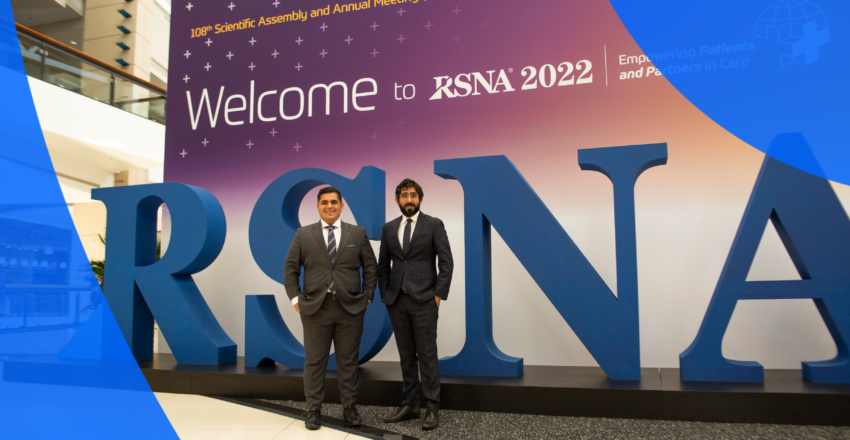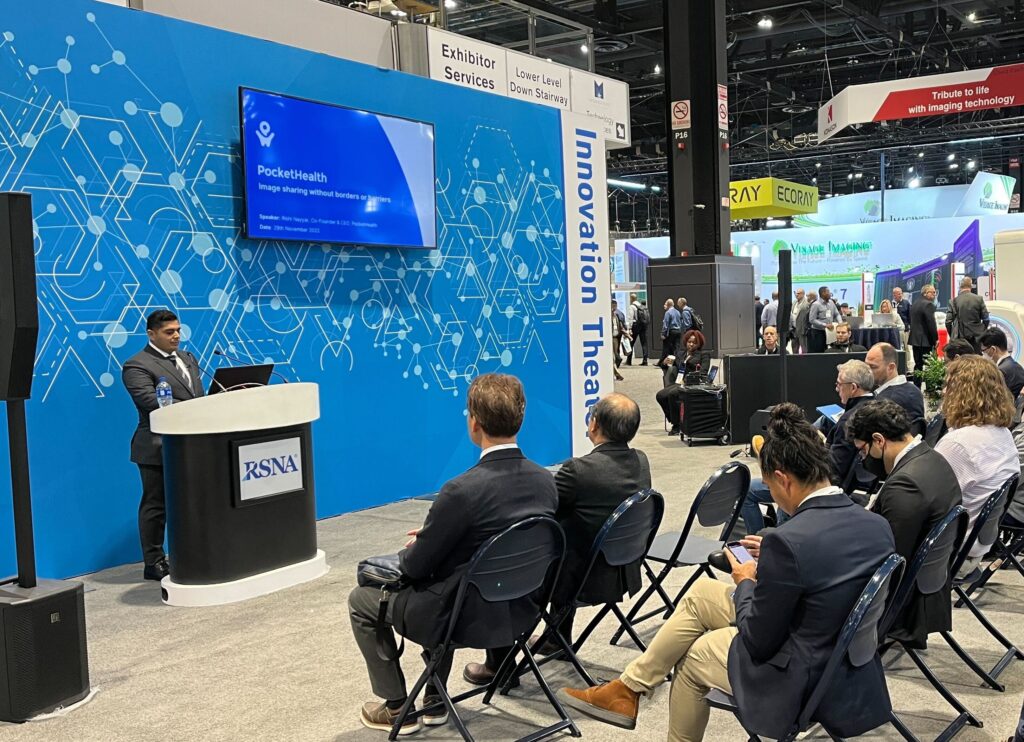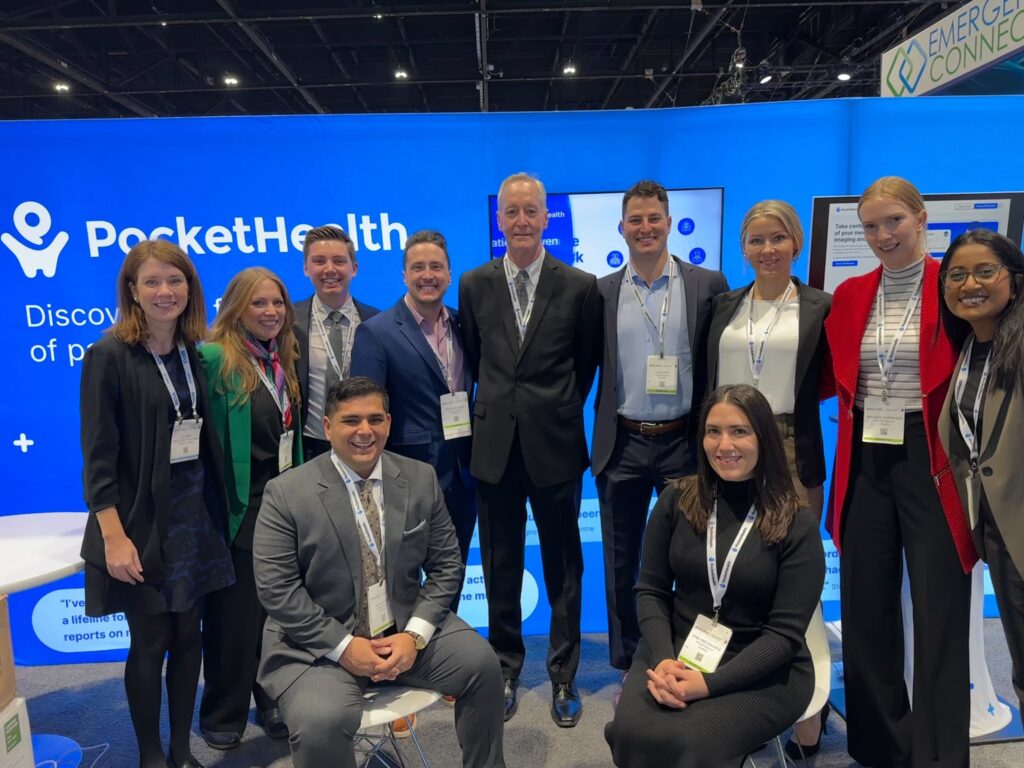Expect More From Your Enterprise Image Exchange: 5 Questions to Ask About Your Current Solution
April 23, 2024
Read More

I’ve been attending RSNA since 2017 and this year was by far the most memorable. While I always look forward to meeting our customers face-to-face and showcasing PocketHealth’s technology, I also look forward to speaking with attendees at our booth and hearing their perspectives on the latest imaging trends. But throughout interactions and speaker presentations, there were clear themes that came up repeatedly. Like past meetings, a few key trends surfaced and will continue to come up in the year to come. Here’s a shortlist of those top trends and themes that emerged during the meeting:
Patient-Centric Care Starts with Patient Data
At the opening plenary address, RSNA President Dr. Bruce G. Haffty, MD. discussed diagnostic imaging value from the lens of the patient – a fitting way to kick off this year’s theme of patient centricity. Haffty solidified that patient centricity goes hand-in-hand with value-based care, and achieving both of these originates with data.
Up until now, there’s been an emphasis on procedure-oriented care which captures traditional metrics (medication dependency, laboratory measures, hospital admissions). But value-based and patient-centric care requires more focus on patient-reported outcomes (PROs), like quality of life, well-being, ease of anxiety.
While patient-reported outcomes grow in popularity, they remain relatively understudied and under-reported. That’s because PROs focus less on clinical outcomes, which measure treatment and diagnostic efficacy, and more on care delivery itself – providing a broad variety of tools that help demonstrate the impact of radiological interventions on the patient through care experience. There remains an opportunity to consider the overall patient journey, from before till after imaging exams and procedures, and PROs can help evaluate quality of care.
Why Bigger Networks are Not Better
While researchers shared their clinical data at the scientific sessions, the exhibition hall hosted technology vendors seeking to solve the most persistent imaging challenges faced by providers. Radiology’s impact on patient-centric care was already on attendees’ minds, which created a space to discuss the ways in which patient experience could be improved with technological intervention. This year, I had the opportunity to present those concepts as a speaker and discuss PocketHealth’s approach to patient-driven image-sharing.
Most organizations approach challenges in patient image-sharing in one of two ways: through acquisitions that build bigger networks or through workarounds that add workflow complexity and clicks. There’s a misconception that building a bigger network will make image storing and sharing more accessible for patients, when in reality it creates a cycle of ineffective solutions necessitating further investment. When providers need to share imaging with an out-of-network site, they encounter a series of administrative burdens. They’re then forced into a complex workflow that adds more time and clicks. In many cases, facilities are ultimately forced to revert back to using CDs, causing a poor experience for both providers and patients.
The pain points created by complex networks can be alleviated with a network-free solution. Since PocketHealth meets this criterion, it enables faster and easier access to imaging and universal sharing, enabling providers in outside networks to obtain imaging electronically, without administrative hassle.

The rigidity of complex networks is often the culprit of non-compliance, creating barriers to achieving interoperability. This year at RSNA, the 21st Century Cures Act was once again a hot-button issue. With the October update to the 21st Century Cures Act Final Rule information blocking provisions, some providers are still scrambling to find an integrated solution that enables patients to securely access imaging without complicating workflows.
With so many competing networks in the marketplace, it’s imperative that new technology readily integrates with existing patient portals. We highlighted this at the AI in Practice Demonstration, by showcasing how PocketHealth integrates into the post-imaging process, reducing friction for the patients, but also minimizing extra work on the part of providers.
Among other issues providers had with the Cures Act, radiologists at RSNA were divided over whether or not patients should have immediate access to reports. There were two schools of thought around access and dangers of that access: The first asserts that immediate release is beneficial and promotes patient-centered care and autonomy, empowers patients to participate in care, improves communication and decreases radiologist liability.
The second school of thought sees mainly downsides to patient imaging access because it eliminates time for referring clinicians to review, reflects uncertainty from lack of access to full medical record, increases anxiety, exacerbates physician burnout and lacks context for interpretation of results.
The concerns of the latter are valid, but the value of immediate access for patients provides greater benefit to healthcare systems altogether. It reduces delays in follow-up care for patients and they can be better prepared for appointments. As well, hospitals then field fewer inquiries from patients regarding when they can expect access to their imaging.
There are also ways to manage patient expectations and make reports more patient-friendly. For instance, every imaging report on PocketHealth features Report Reader. This tool provides in-browser patient-friendly definitions of medical terms to prevent patients from going down an online rabbit hole, which only creates more anxiety.
AI Integration in the Post-Imaging Process
The conversation around AI and radiology is an RSNA staple, and this year was no exception. With the conference theme in mind, tech vendors were tasked with identifying AI solutions that add to patient-centered care.
Healthcare professionals and companies too often focus on AI and other technologies for everyone except the patients. They’re using technology, AI and natural language processing to improve workflows for radiologists in the form of assisted image reading, report generation and measurement. But it almost always ends at the radiologist generating the report.
The missing puzzle piece is where technology and AI come in to enhance the experience after these processes are complete. Not enough companies are asking the question: how do we leverage technology to improve the experience for the patient after imaging and reports have been completed or before their next appointment?

Design Is Intelligence Made Visible
There was also discussion on how design drives the patient experience. In the post-pandemic world, everything is viewed through an experience lens. Facilities are taking into account physical, digital and staff touchpoints when designing an environment for patient experience.
For example, hospitals adopted new measures to make patients feel safe and comfortable as COVID-19 started to spread in 2020. We see organizations across industries applying these strategies to their products and services. There were even several comparisons made between healthcare centers and airports, where there’s consideration for every step in the process from check-in, to bag check, to security and boarding. Similarly, emergency rooms implemented hygiene stations, a series of check-ins, waiting rooms, triage, vitals check and appropriate next steps.
CDs, for instance, were a hassle – patients had to physically go pick up their disks and deliver them to their physicians. Since most computers don’t have a CD drive, they were also inaccessible for patients to view. This could be mitigated by a platform that uploads imaging automatically and enables patients to instantly share with their providers, reducing touchpoints and design inefficiencies.
While COVID accelerated the need for patient-centered design, there’s still a lot of work to be done to show what that looks like in practice – across human, physical and digital touchpoints.
With an unparalleled RSNA 2022 in the rearview, I look ahead and continue reflecting on these key themes. The discussions around patient experience have the potential to shift mindsets and transform the patient experience in health systems and imaging centers everywhere. It was a pleasure chatting with so many healthcare leaders at the booth and I look forward to coming back and continuing these intriguing discussions next year.